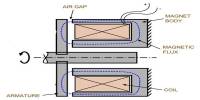When cell phones, electric vehicle chargers, or other electrical devices become too hot, their performance suffers, and they may eventually shut down or fail due to overheating.
Researchers are striving to overcome the problem of dissipating heat generated during the performance to avoid this from happening. The heat created in the device during operation must be able to escape as quickly as possible to keep the temperature from rising.
During the process, thermal energy must frequently pass through numerous dissimilar materials, and the interface between these materials can obstruct heat flow, posing a problem.
Researchers from Georgia Tech, Notre Dame, University of California Los Angeles, University of California Irvine, Oak Ridge National Laboratory, and the Naval Research Laboratory discovered interfacial phonon modes that exist only at the interface between silicon (Si) and germanium (Ge) in a recent study.
This study, which was published in the journal Nature Communications, demonstrates that decades-old conventional theories for interfacial heat transport are incomplete and that the inclusion of these phonon modes is necessary.
“The discovery of interfacial phonon modes suggests that the conventional models of heat transfer at interfaces which only use bulk phonon properties are not accurate,” said the Zhe Cheng, a Ph.D. graduate from Georgia Tech’s George W. Woodruff School of Mechanical Engineering who is now a postdoc at the University of Illinois at Urbana-Champaign (UIUC).
“There is more space for research at the interfaces. Even though these modes are localized, they can contribute to thermal conductance across interfaces.”
The discovery provides up a new avenue to consider when designing thermal conductance at interfaces for electronics cooling and other applications in which phonons are the predominant heat carriers at material interfaces.
The discovery of interfacial phonon modes suggests that the conventional models of heat transfer at interfaces which only use bulk phonon properties are not accurate. There is more space for research at the interfaces. Even though these modes are localized, they can contribute to thermal conductance across interfaces.
Zhe Cheng
“These results will lead to great progress in real-world engineering applications for thermal management of power electronics,” said co-author Samuel Graham, a professor in the Woodruff School of Mechanical Engineering at Georgia Tech and new dean of engineering at the University of Maryland.
“Interfacial phonon modes should exist widely at solid interfaces. The understanding and manipulation of these interface modes will give us the opportunity to enhance thermal conductance across technologically-important interfaces, for example, GaN-SiC, GaN-diamond, β-Ga2O3-SiC, and β-Ga2O3-diamond interfaces.”
Presence of Interfacial Phonon Modes Confirmed in Lab
Using Raman Spectroscopy and high-energy resolution electron energy-loss spectroscopy (EELS), the researchers discovered the interfacial phonon modes experimentally at a high-quality Si-Ge epitaxial interface.
In labs at Georgia Tech and UIUC, they employed a technique called time-domain thermoreflectance to determine the temperature-dependent thermal conductance across these surfaces to figure out the significance of interfacial phonon modes in heat transport at interfaces.
They also saw a clean extra peak in Raman Spectroscopy measurements while measuring the sample with the Si-Ge interface, which they didn’t see when measuring a Si wafer and a Ge wafer with the same instrument.
Both the observed interfacial modes and the thermal boundary conductance were fully captured by molecular dynamics (MD) simulations and were restricted to the interfacial region, as expected by theory.
“This research is the result of great teamwork with all the collaborators,” said Graham. “Without this team and the unique tools that were available to us, this work would not have been possible.”
The researchers intend to investigate the measurement and prediction of interfacial modes in the future, as well as a better understanding of how these phonon modes contribute to heat transfer and techniques to modify these phonon modes to boost thermal transport.
Breakthroughs in this area could lead to improved performance in satellites, 5G devices, and enhanced radar systems, among other things. The epitaxial Si-Ge samples used in this research were grown at the U.S. Naval Research Lab.
The TEM and EELS measurements were done at the University of California, Irvine, and Oak Ridge National Labs. The MD simulations were performed by the University of Notre Dame. The XRD study was done at UCLA.
















